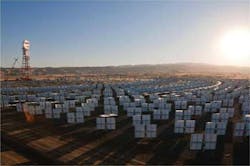Chevron Corp. has started generating steam from its solar-to-steam demonstration project for enhancing oil recovery at the heavy oil Coalinga field in Kern County, Calif.
The project includes 3,822 heliostats, which are mirror systems consisting of two 10 ft by 7-ft mirrors mounted to a 6-ft steel pole. Each heliostat tracks the sun on two axes and directs the sun's rays to a receiver on top of a 327-ft tower.
The rays heat water in a boiler on top of the tower to generate steam in a closed process loop. Heat from the process loop then circulates through a heat exchanger at the base of the tower and heats water to generate steam for injection into wells at Coalinga.
The demonstration project covers 65 acres of a 100-acre property wholly owned by Chevron and started generating steam on Aug. 23.
BrightSource Energy Inc. built and helped engineer the Coalinga solar-to-steam installation. Besides EOR, BrightSource also has projects for the technology in which the steam turns a turbine for power generation.
Site selection
Jerry Lomax, vice-president emerging energy for Chevron, told OGJ one reason Chevron choose this system is its flexibility as to steam temperature, pressure, and quality.
He said the generated steam from the demonstration project will supplement gas-powered steam generators at Coalinga to provide about 5% of the steam needed to produce the 8,700 b/d of 9-14° gravity heavy oil from the field.
As currently configured, the installation produces 60% quality steam at 500° F. and 700 psi. It is designed to produce 690,000 bbl/year of steam or 240 million lb/year of steam.
The produced steam is about the same amount as output by a gas-fired steam generator that is the size of a large semitrailer truck compared with the demonstration project's 65 acres.
Chevron based its selection of the site on the availability of:
• High solar radiation.
• Enough acres of land with a flat topography.
• Land close to the injection wells.
Lomax added that the system uses very little fresh water because of the closed process loop in the tower that recycles the process water, and Chevron injects into the wells steam generated from produced water.
Assessing the technology
Chevron will monitor and gather data to determine if the technology is economically viable and practical for other Chevron locations.
The demonstration project may have a 20-year life, although Lomax said Chevron should have good data within a year as to operating costs and reliability.
Lomax noted that problems at Coalinga include dust, wind, and hail that may add costs and hamper reliability. Chevron expects to require eight full-time employees at the site.
Lomax noted that a commercial project of the technology would cover about 500 acres compared with the 65 acres at Coalinga, and that Chevron could expand the site at Coalinga to a full 360° of heliostats around the tower.
Chevron built the central tower at Coalinga on the same scale as a commercial installation, but a higher tower height would allow for the installation of a higher density of heliostats, providing more steam per acre, Lomax said.
Other prerequisites for commercial deployment of these systems are high natural gas prices or difficulty in accessing a gas source. "With low gas prices, this technology cannot compete," Lomax said.
Earlier this year, GlassPoint Solar Inc. installed a 1-acre single transit trough with a glasshouse enclosure at Berry Petroleum Co.'s heavy oil 21Z lease in McKittrick, Calif., to generate about 1 million btu/hr of solar heat to assist steam generation (OGJ Online, Feb. 24, 2011).
More Oil & Gas Journal Current Issue Articles
More Oil & Gas Journal Archives Issue Articles
View Oil and Gas Articles on PennEnergy.com

Guntis Moritis | Production Editor
Guntis Moritis has covered production and drilling technology for the Oil & Gas Journal since January 1988. Previous to that, he worked for several major oil companies in the areas of drilling, production, and reservoir engineering. Moritis has a degree in petroleum engineering from the Colorado School of Mines.



